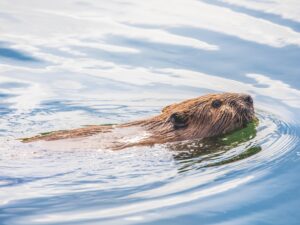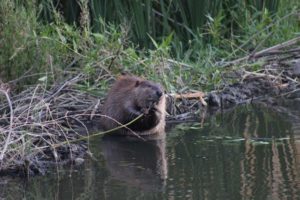In summer 2008, Bay Nature reported on a family of beavers that had taken up residence in downtown Martinez. At the time, a City Council vote threatened them with removal from Alhambra Creek, where there was some concern that the beavers could cause flooding problems.
Beaver advocates prevailed, and the beaver family is doing well thanks to a successful campaign waged by the organization Worth a Dam. After all the attention, the City Council declined to vote on the removal of the beavers. “No one wanted to be the person to vote against them,” Worth a Dam founder Heidi Perryman says. The beaver family is now busy raising three yearlings; two yearlings from last year have left the pond to strike out on their own. The family has drawn human visitors from as far away as Orange County and has also starred in a number of school and summer camp field trips.
Now the beavers are showing their remarkable abilities to create habitat for other species as well. Beaver watchers have spotted mink, otter, steelhead trout, and a variety of bird species near the intersection of Castro and Escobar Streets. To help the beavers along, Worth a Dam planted arroyo willow and cottonwood trees both this year and last year. When beavers chew down these trees, they grow back bushier, which attracts more migratory birds to the sheltered, dense growth.
- A mink family has moved in near the beaver pond in Martinez. Photo by Cheryl Reynolds, courtesy Worth a Dam.
Not only do the beavers attract other species, but they also help create the conditions of a healthy watershed. Perryman would like more people to consider beavers in the context of the Bay Area’s troubled salmon populations, which get so much attention. Beavers and their ponds are seen as a nuisance by many people, and one might think that their dams would be a problem for salmon. But it’s not so simple. “Salmon need deep cool water that pools provide, and beavers create those,” explains Chris Pincetich, a watershed biologist for SPAWN, which restores habitat for coho salmon in Marin County. “The important point is that before rampant disturbance of the watershed, these species evolved together. Beavers are part of a healthy watershed.” Currently, in Lagunitas Creek, SPAWN and others are spending hundreds of thousands of dollars to install wood debris structures, which help the salmon by creating those cool pools. Beavers would do that for free.
What Martinez residents are discovering is that beavers do not exist in isolation. The general habitat creation by beavers reestablishes conditions in which animals in this area have evolved to thrive. “There are so many conditions we don’t even know about,” says Pincetich. “When it comes down to it, taking out one aspect of this complicated web of life can cause other areas to collapse.” And bringing one back may allow others to flourish once again.

.jpg)




